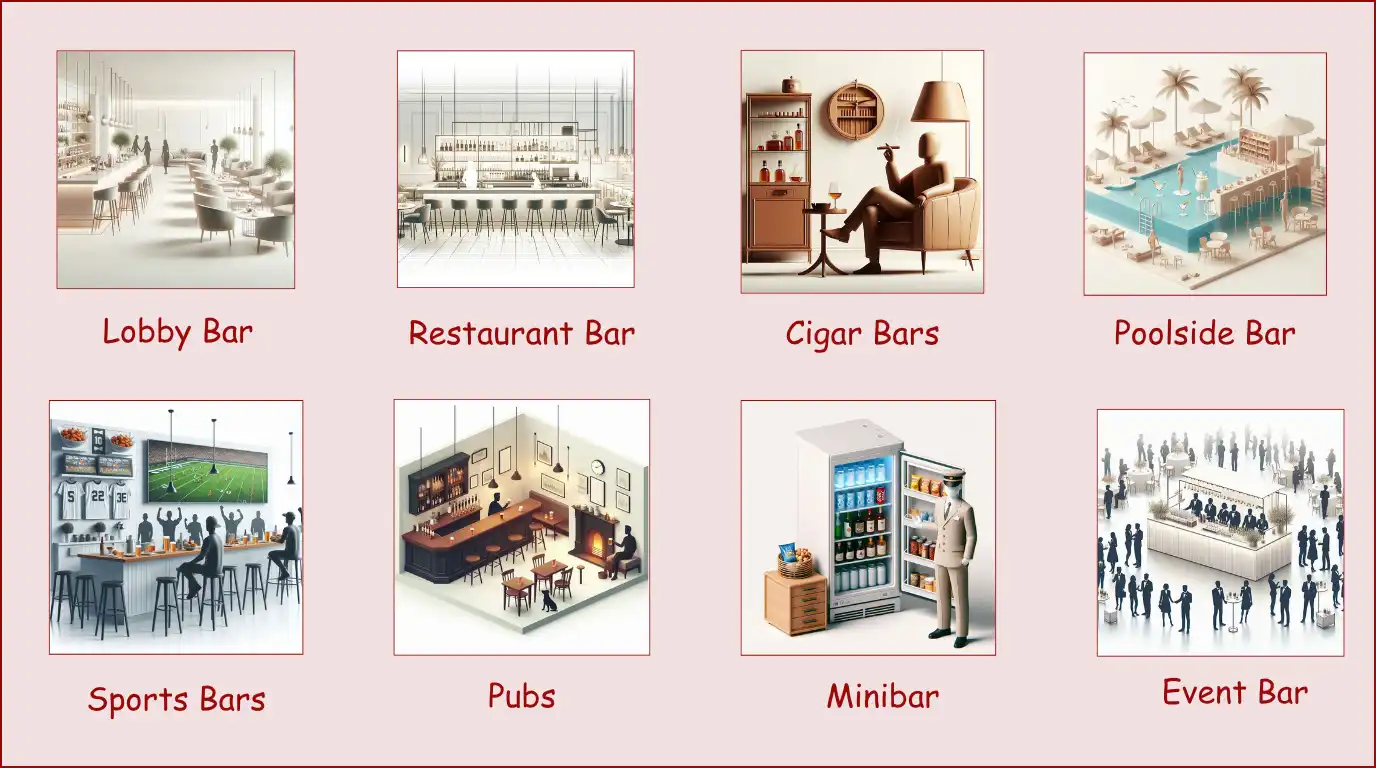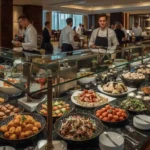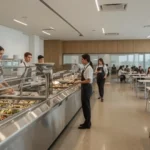Bars in the hospitality industry are more than just drink stations—they’re strategic spaces that shape guest experience, enhance food and beverage service, support operations, and drive revenue. From stylish rooftop lounges to hidden speakeasies and efficient service bars, each type plays a distinct role in a property’s success.”
In this article, you’ll discover:
- Key types of bars found in hotels, resorts, and event venues
- How bars are classified by function, theme, and beverage focus
- Real-world examples and operational insights for each bar type
Whether you’re a hospitality professional or an enthusiast, this guide offers insights into how bars, as key outlets within a venue, enhance guest engagement while driving overall business performance.
Clarification: Bar vs. BAR
In hospitality, the term “bar” can lead to confusion due to its dual usage. While it most commonly refers to a beverage-serving venue, BAR (Best Available Rate) is a hotel revenue management term that refers to the lowest publicly available rate for a room, without restrictions. It’s crucial for hospitality professionals—especially those cross-trained in front office, F&B, and sales—to understand the distinction to avoid miscommunication in daily operations.
Guest-Facing & Revenue-Generating Bars
1. Lobby Bar / Lounge
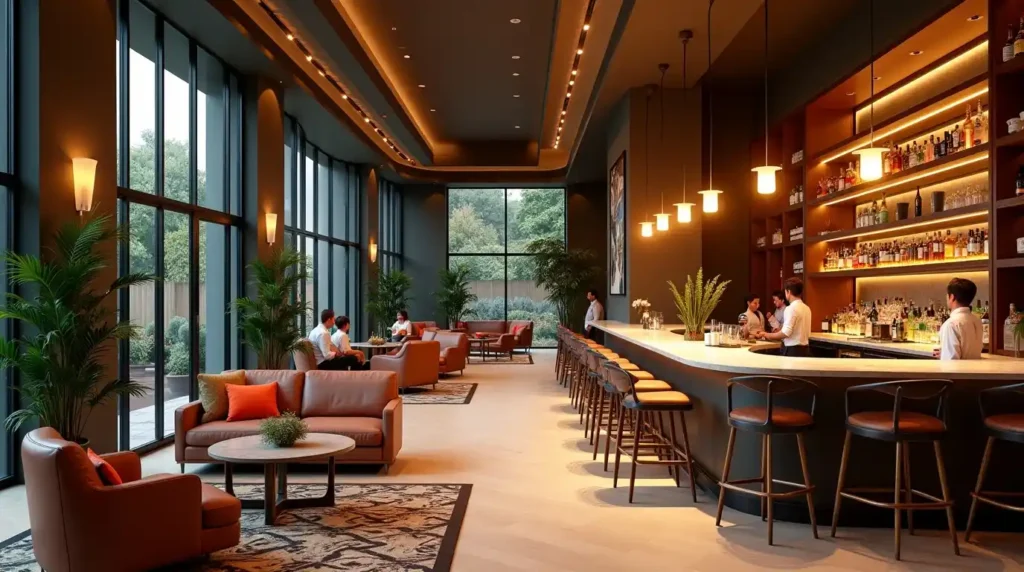
The lobby bar or lounge often serves as the hotel’s social living room and a key first impression for guests entering the property. It’s designed with comfort and ambience in mind—typically featuring an open layout, stylish furniture, and inviting lighting to encourage guests to relax, socialise, or conduct informal meetings. Positioned in or near the hotel lobby, this bar is not just a waiting area but a carefully curated environment that reflects the property’s identity. It usually operates throughout the day, transitioning seamlessly from coffee in the morning to cocktails in the evening.
- Menu: Full bar, cocktails, wine, light bites
- Service: Table service, relaxed and welcoming
Staffing typically includes skilled bartenders, attentive servers, and a host or hostess to welcome guests.
Example: Hey Love – Jupiter NEXT Hotel, Portland, OR. A lush, tropical-themed hotel lobby bar known for its vibrant cocktails and communal vibe.
2. Restaurant Bar
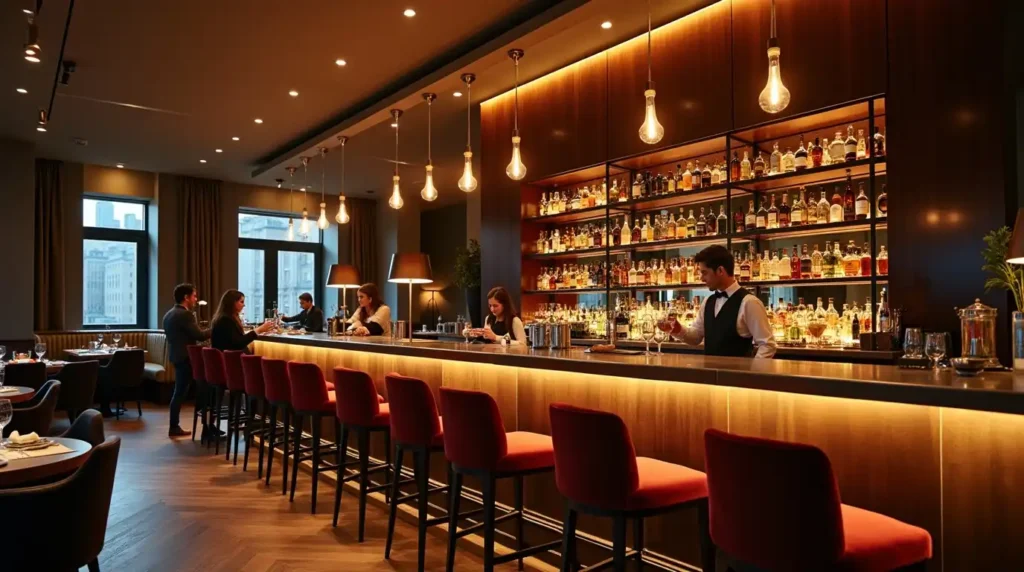
A restaurant bar is integrated into a hotel’s restaurant space and plays a dual role. It supports the dining area by preparing drinks for seated guests and also functions as a destination in itself, particularly if the restaurant has a reputation for its wine list or cocktail program. The design of this bar aligns closely with the restaurant’s overall theme, whether it’s casual, fine dining, or fusion. It’s a key part of the dining experience, offering guests a place to start their meal with an aperitif or conclude it with a digestif.
- Menu: Wine pairings, aperitifs, digestifs, craft cocktails
- Service: Hybrid – bar seating with direct ordering, plus server-submitted orders
The restaurant bar is staffed with bartenders and often overseen by a Bar Manager or Beverage Director who ensures seamless coordination with the kitchen and dining staff.
Learn how bars, as key outlets in hospitality, enhance guest engagement and business performance in our detailed guide on the sequence of service in restaurants.
3. Poolside Bar
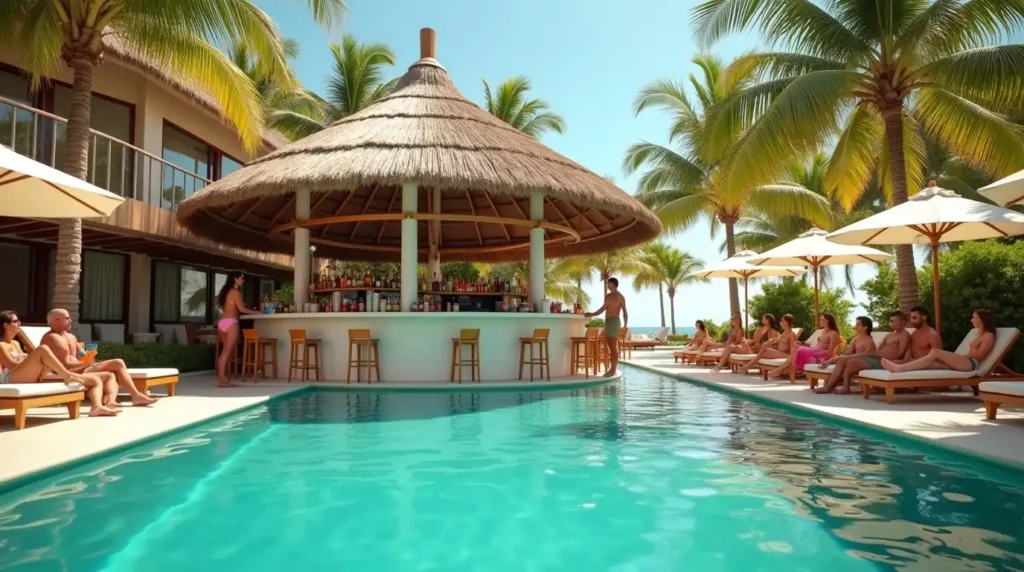
Found at resorts and leisure-focused properties, the poolside bar caters to guests enjoying outdoor amenities. Its primary function is to enhance the relaxation and leisure experience by providing refreshments in a convenient and fun setting. These bars are typically open-air, casual in design, and located near or within the swimming pool area. Many feature swim-up access or are supported by roaming servers delivering drinks to sun loungers or private cabanas.
- Menu: Frozen cocktails, beer, juices, soda, light snacks or small meals
- Service: Poolside or cabana delivery, swim-up bar, walk-up counter
Bartenders often work alongside cocktail servers to ensure prompt and friendly service.
Example: LIQUID Pool Lounge – ARIA Resort & Casino, Las Vegas. Upscale swim-up bar and day club offering cocktails and poolside cabana service.
Operational & Support Bars
1. Service (Dispense) Bar
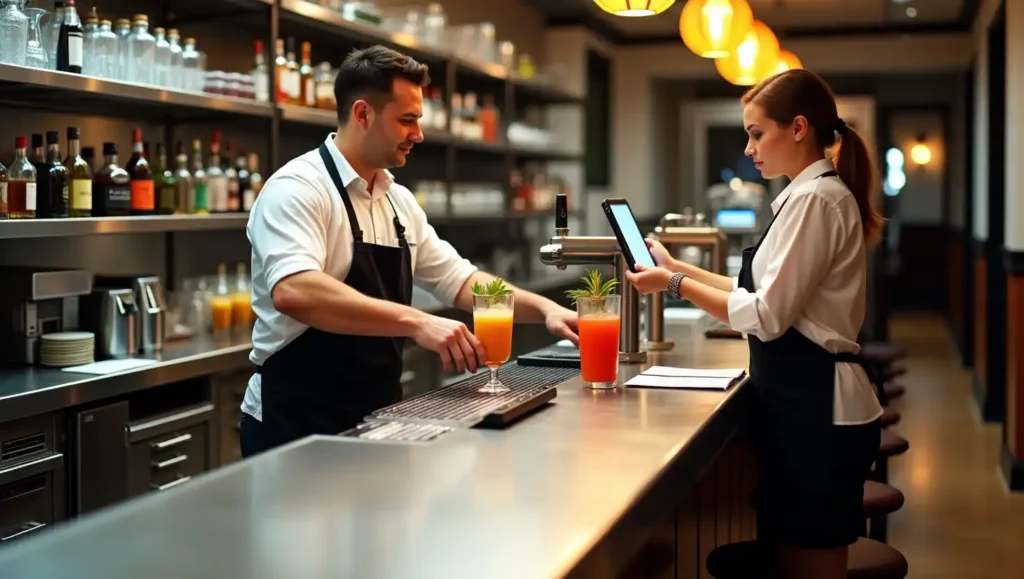
Unlike guest-facing bars, a service bar is located behind the scenes and is dedicated solely to fulfilling drink orders placed by waitstaff. These bars are essential in busy restaurants, lounges, and banquet halls, enabling the efficient delivery of beverages without guests interacting directly with the bar itself. Designed for function rather than aesthetics, a service bar is usually compact and streamlined for speed.
- Menu: No guest-facing menu – prepares all drink orders submitted by servers
- Service: Not open to guests – drinks are served by waitstaff at tables
Staffed exclusively by service bartenders, these bars play a critical role in maintaining service flow during high-volume periods.
2. Banquet / Event Bar
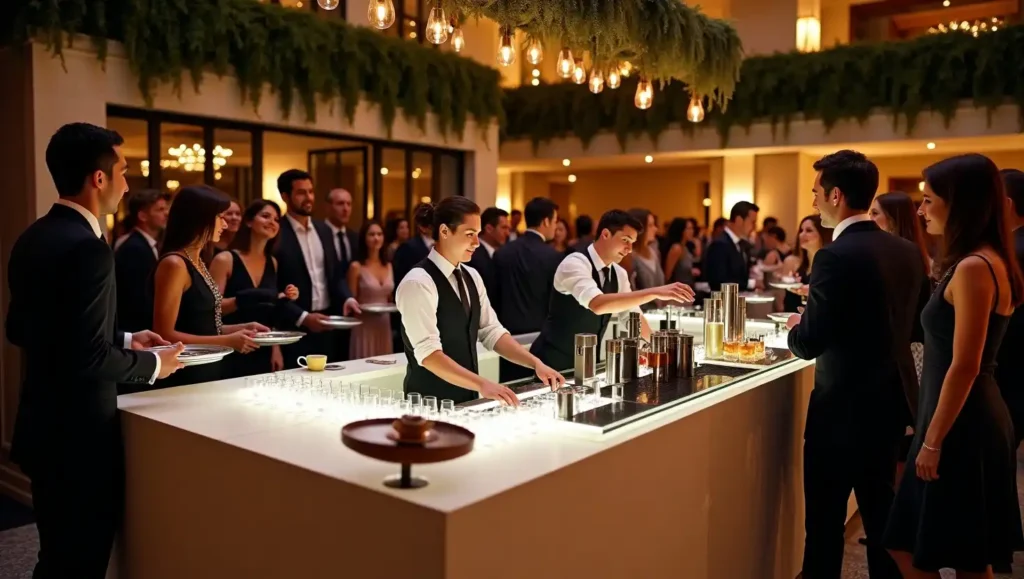
Banquet or event bars are temporary setups designed to serve beverages at functions such as weddings, galas, or conferences. They are highly customizable, depending on the nature and budget of the event. Unlike permanent bars, these are modular and can be branded or themed to match the occasion. Their design prioritises efficiency, and the layout must support high guest volume over a short period.
- Menu Options: Open bar, cash bar, ticket-based, or consumption-based packages
- Service: High-volume, fast-paced, either self-serve or full-service, depending on event style
Staffing consists of trained banquet bartenders capable of handling large crowds quickly and courteously.
3. Minibar
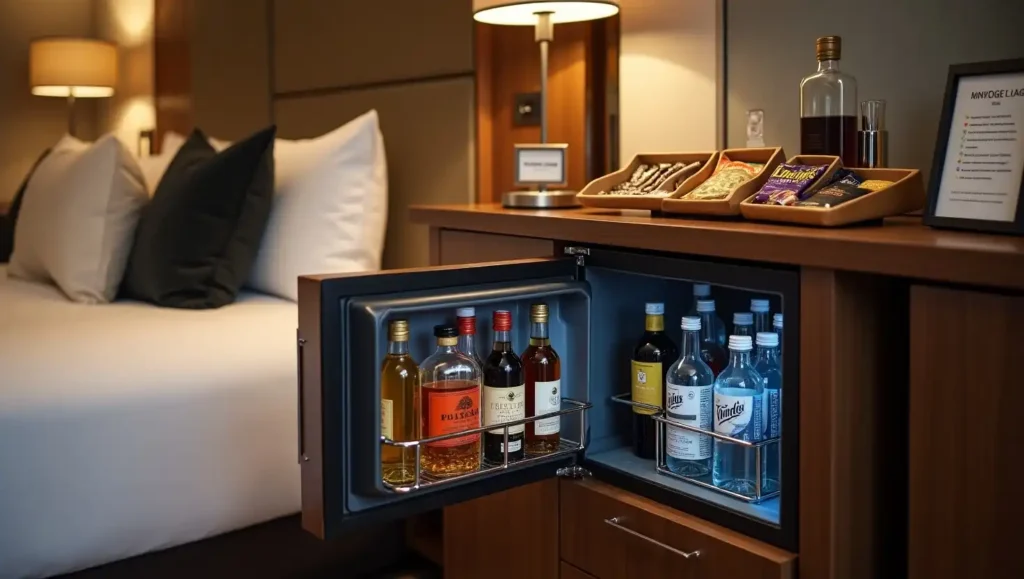
Minibars are small, in-room refreshment setups typically consisting of a mini-fridge and snack tray. While often overlooked, minibars represent a passive revenue stream and can significantly enhance guest satisfaction when stocked thoughtfully. They are designed to offer guests privacy and convenience, particularly for late-night cravings or short stays.
- Menu: Mini spirits, wine, soda, water, chocolate, nuts, chips
- Service: Self-service, replenished daily or upon request
Operations involve minibar attendants who are responsible for restocking items, monitoring consumption, and ensuring timely room billing. To see how minibars align with in-room hospitality offerings, explore our comprehensive guide on room service in hotels.
Classification by Concept, Theme, and Ambience
Beyond their operational role, bars are often defined by the specific experience they are designed to deliver. This classification focuses on the consumer-facing elements—such as concept, theme, décor, and ambience—which work together to attract a particular target demographic and create a distinct brand identity.
A. The Social & Casual Hubs:
These bars are built around comfort and connection, offering patrons a laid-back environment that encourages group interaction and a sense of community.
1. Pubs & Taverns
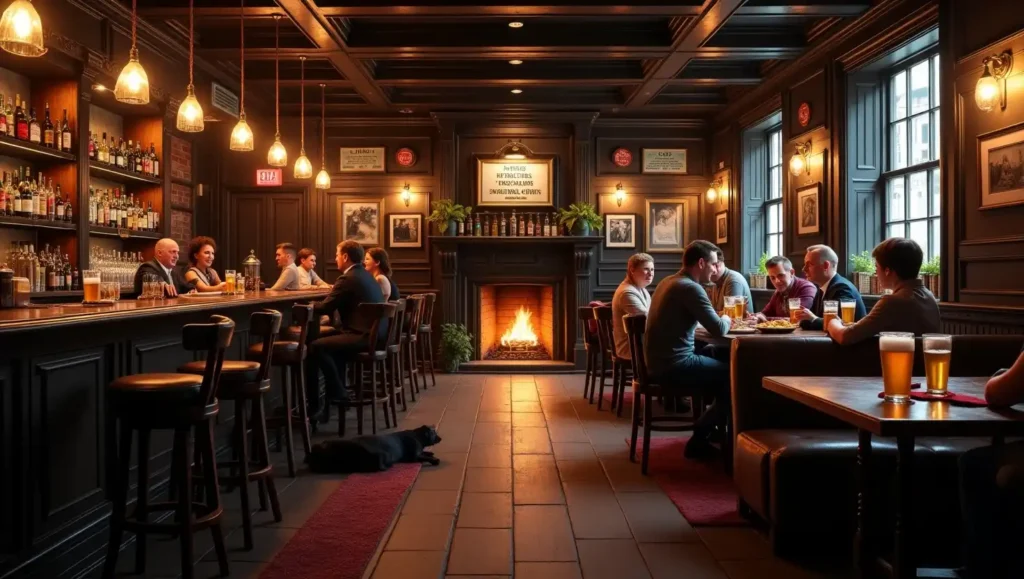
Rooted in British and Irish tradition as “public houses,” pubs and taverns are designed to feel like a second home—cosy, relaxed, and filled with familiar faces. With an emphasis on community over formality, they feature hearty menus and are heavily beer-focused, especially on draught ales and lagers. These bars often have fireplaces, wooden furnishings, and an atmosphere built for long stays.
Example: The Dandelion Pub in Philadelphia, with rooms like the ‘Dog Room,’ elevates the cosy pub experience while preserving its authenticity.
2. Gastropubs
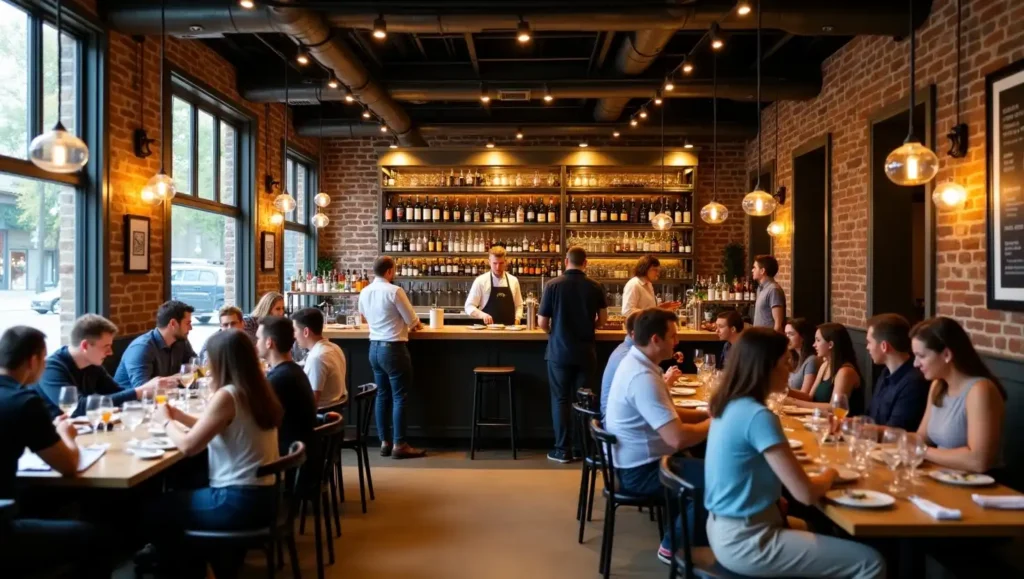
An evolution of the traditional pub, gastropubs combine the easygoing vibe of a tavern with a serious focus on culinary quality. These venues are chef-driven, emphasising seasonal, locally sourced dishes that reimagine comfort food classics with sophistication.
- Menu: Elevated comfort cuisine, often plated creatively
- Service: Casual yet polished table service
The beverage program mirrors the food quality, featuring craft beers, curated wines, and refined cocktails. Gastropubs appeal to diners seeking high-quality food in an unfussy atmosphere.
3. Sports Bars
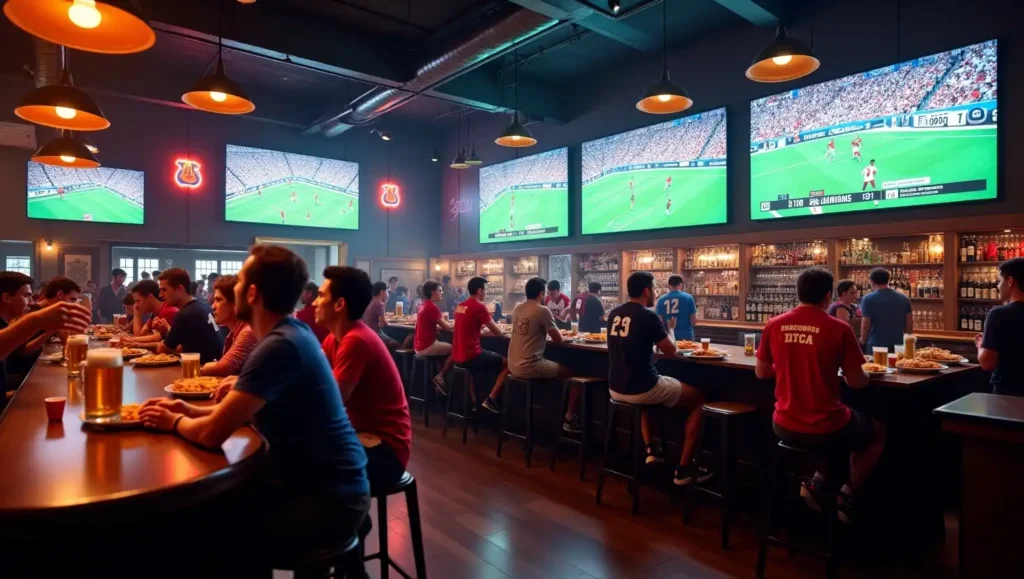
Designed for communal viewing of live sports, sports bars are defined by their abundance of large-screen TVs and energetic ambience. On game days, these venues come alive with fan enthusiasm. Décor typically includes jerseys, memorabilia, and bold team branding, while layouts prioritise clear sightlines to the screens.
- Menu: Classic bar food (wings, nachos, burgers, pizza), beer pitchers
- Service: Quick, casual, and group-friendly
The key to success lies in high-quality audio-visual systems and strong game-day programming that fosters repeat business from loyal fans.
Example: Buffalo Wild Wings (Multiple Locations). Popular chain featuring live sports, beer pitchers, and classic bar food.
4. Dive Bars
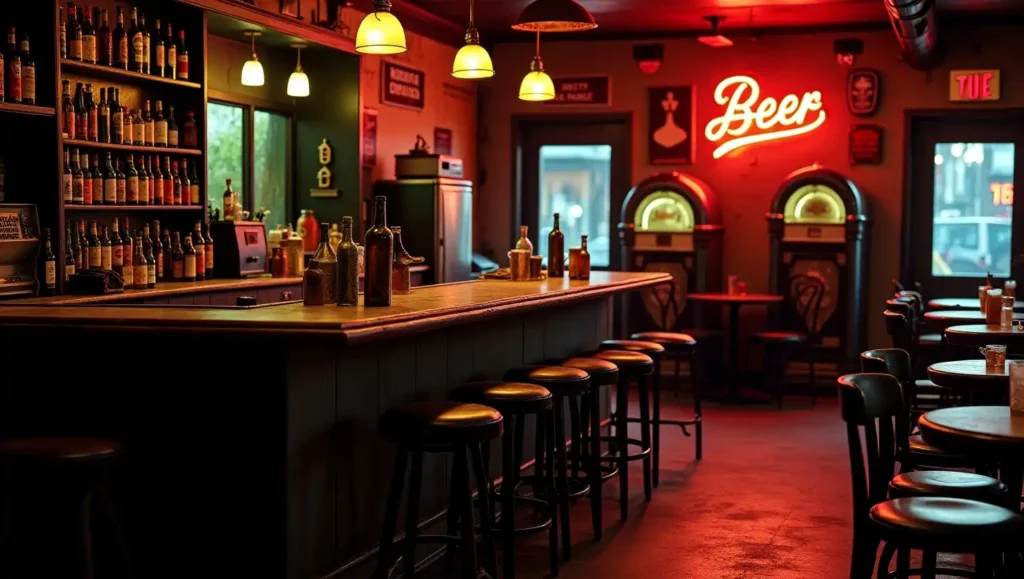
Often small, dimly lit, and unpolished, dive bars embrace a no-frills, come-as-you-are mentality. They typically serve inexpensive drinks in a cash-only environment, with little attention to aesthetics but a strong focus on authenticity.
These establishments thrive on loyal, local clientele who value the genuine atmosphere. From a business standpoint, dive bars offer low overhead and high-volume potential, supported by strong repeat customers who come for the experience, not the decor.
The Sophisticated & Refined Experiences
These bars appeal to a more discerning clientele by emphasising ingredient quality, craft, and ambience. Quiet conversations and carefully curated menus define this category.
1. Cocktail Lounges

Cocktail lounges celebrate the artistry of mixology. These venues often have an upscale, stylish design and feature carefully crafted cocktails made with premium spirits, fresh ingredients, and complex techniques.
- Menu: Signature cocktails, premium spirits, house-made syrups and infusions
- Service: Seated, attentive, and knowledge-driven
The bartenders here are often referred to as mixologists, whose role extends beyond pouring drinks to innovating recipes and mastering flavour balance.
Example: The Aviary – Chicago, IL: A high-end cocktail bar famous for theatrical mixology and avant-garde drinks.
2. Wine Bars
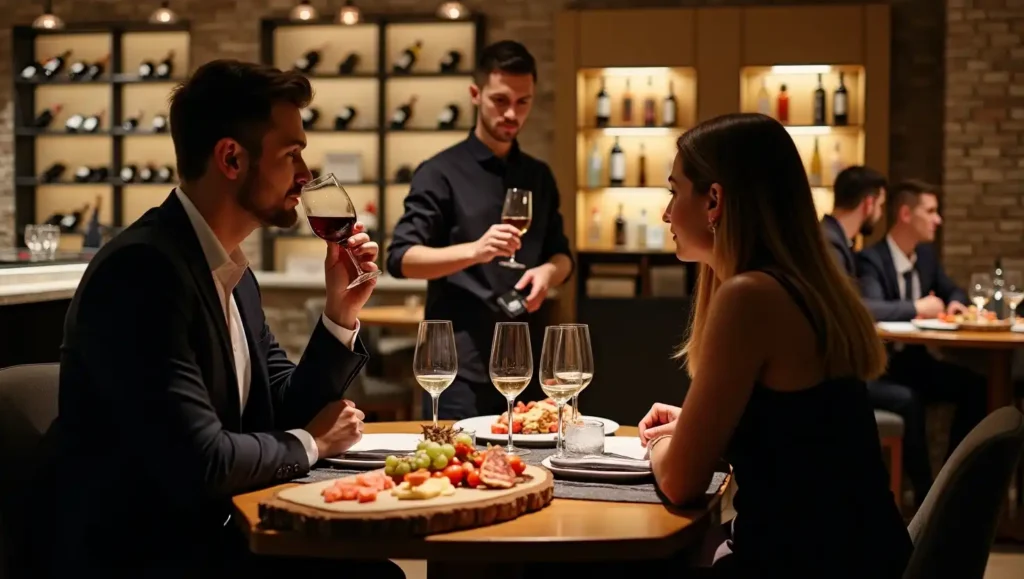
Focused on a global, curated wine experience, wine bars offer a wide selection of wines by the glass, encouraging exploration and education. These venues are typically quiet and elegant, fostering a relaxed yet sophisticated environment ideal for conversation.
- Menu: Wine flights, global varietals, cheese boards, charcuterie
- Service: Staff-guided tastings, sommelier recommendations
Highly trained staff or sommeliers are essential to guide guests through the list and suggest pairings, making education a core part of the experience.
Example: Amelie Wine Bar – New York City: Elegant wine lounge offering global varietals, flights, and cheese boards.
3. Speakeasies
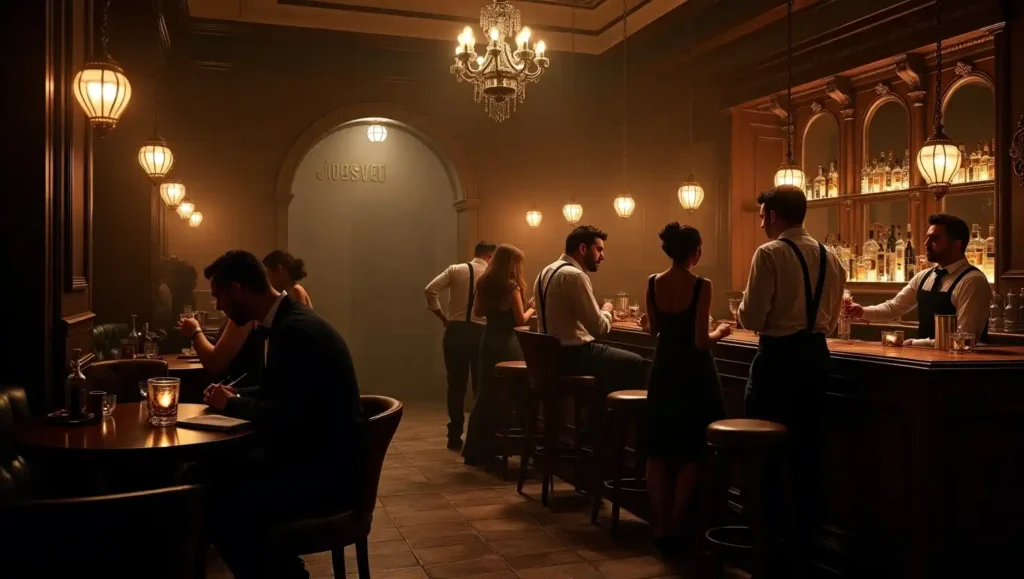
Speakeasies revive the hidden bars of Prohibition-era America, prioritising secrecy and theatricality. Guests often enter through unmarked doors, password-protected entrances, or behind unexpected façades, such as phone booths or bookcases.
Once inside, the ambience is immersive—dim lighting, vintage décor, and jazz set the tone.
- Menu: Classic prohibition-era cocktails, often prepared with historical accuracy
- Service: Intimate and detail-oriented
Example: Please Don’t Tell (PDT) in NYC, hidden inside a hot dog shop.
Speakeasies create buzz through exclusivity and social media intrigue, making them experiential destinations as much as drinking spots.
4. Cigar Bars
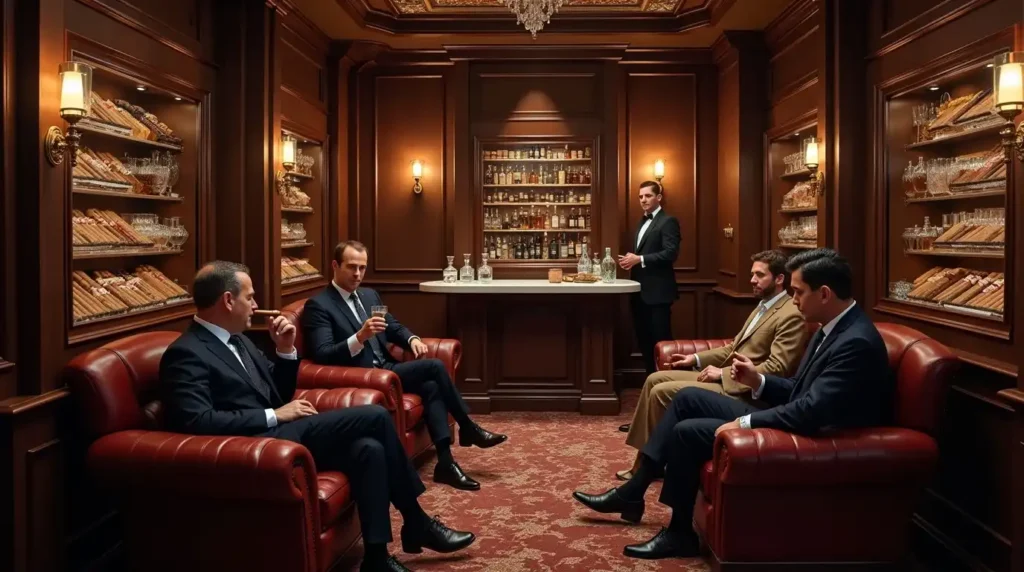
Cigar bars offer a luxurious, club-like environment where patrons can enjoy premium cigars alongside top-shelf spirits like whiskey, brandy, and cognac. Essential elements include well-maintained humidors and high-end ventilation systems.
These bars are often attached to upscale hotels or private clubs, catering to a niche market of high-spending clientele seeking leisure, luxury, and indulgence.
The High-Energy & Entertainment Venues
In these settings, the bar program supports a larger entertainment experience—whether that’s dancing, music, or social games.
1. Nightclubs
Nightclubs are designed for nightlife enthusiasts, with music, dancing, and social interaction taking centre stage. These venues prioritise lighting, sound, and layout over comfort.
- Menu: Simple mixed drinks, bottle service
- Service: Fast, high-volume, VIP table service available
The focus is less on cocktail craft and more on volume, speed, and spectacle. Cover charges, table reservations, and premium bottle service drive revenue.
2. Live Music Bars
These bars centre on live musical performances. The stage, sound quality, and performer visibility are key to their design. From jazz trios to rock bands, the genre often defines the venue’s clientele.
- Menu: Casual food and drinks, often tailored to the crowd and performance schedule
- Service: Variable – seated or standing with counter service
Live music bars cater to music lovers and frequently develop a loyal fan base depending on their featured acts.
Example: Green Mill Cocktail Lounge – Chicago, IL. Historic jazz club and cocktail bar with deep Prohibition-era roots.
3. “Competitive Socialising” Bars
These interactive venues combine the appeal of casual drinking with group games and activities. Ranging from retro arcade bars to high-tech VR lounges and indoor golf simulators, the goal is to create fun, participatory social experiences.
- Menu: Playful cocktails, beer towers, snackable food
- Service: Activity zones with a hybrid table and self-service
This fast-growing trend appeals to a broad audience by encouraging longer visits and group outings, naturally increasing spend per guest.
The Escapist & Thematic Destinations
These bars use immersive themes to create a complete escape from everyday life—ideal for storytelling, social media, and unique guest experiences.
1. Tiki Bars
Tiki bars transport guests to a tropical fantasy world through Polynesian-inspired décor like bamboo walls, carved idols, thatched roofs, and lush foliage.
- Menu: Rum-based cocktails with layered flavours and exotic garnishes
- Service: Playful and theatrical, often with elaborate presentations
Tiki drinks are visually iconic, often served in collectable mugs and presented with fire, umbrellas, or other dramatic flair. Success relies on both strong theming and a deep understanding of flavour layering.
Example: Three Dots and a Dash – Chicago, IL. Immersive tropical bar offering rum-heavy cocktails in collectable mugs.
2. Rooftop Bars
Located atop high-rise buildings, rooftop bars draw guests with sweeping views, trendy atmospheres, and fresh air. The space often includes plush seating, plants, fire pits, or pools, and is designed to be highly photogenic.
- Menu: Stylish cocktails, wine, light fare
- Service: Upscale, polished, and often reservation-based
Rooftop bars are major revenue generators, especially in urban or coastal cities, and serve as destination venues for both travellers and locals.
Classification by Beverage Specialisation
Some bars are built entirely around one type of drink—beer, wine, whiskey, or cocktails. Their identity, operations, and customer experience revolve around deep expertise in that specific category. Staff play the role of educators and curators, turning a drink into an experience and justifying premium pricing.
A. Fermented Focus (Beer & Wine)
1. Brewpubs vs. Craft Beer Bars
- Brewpubs brew their own beer on-site.
- Craft Beer Bars serve a curated list of beers from various breweries.
Key to both: clean lines, proper glassware, certified staff, and fresh inventory.
2. Wine Bars (Advanced)
- Run by expert Sommeliers who manage inventory, sourcing, and staff education.
- Success depends on tight operations and proper storage to protect a high-value product.
B. Distilled Focus (Spirits)
1. Whiskey Bars
- Feature large, curated whiskey selections from around the world.
- Staff guide guests through flights and tastings.
- The setting is often cosy, upscale, and club-like.
2. Other Spirit-Specific Bars
- Specialise in one spirit like gin, tequila, mezcal, or rum.
- Offer deep selections and spirit-focused cocktails.
- Often include tastings and educational elements.
C. Cocktail-Centric Bars
- Entirely focused on creative, high-quality mixed drinks.
- Bartenders run the service; Mixologists design the drinks.
- Menus are often seasonal and organised by flavour (e.g., citrusy, bold).
- House-made ingredients and storytelling are central to the experience.
For a deeper understanding of how beverages are categorized, check out our guide on the classification and types of beverages.
FAQs
1. What are the main types of bars in a hotel?
Hotels typically feature lobby bars, restaurant bars, poolside bars, minibars, and service bars. Each serves a unique purpose based on location and guest needs.
2. What’s the difference between a service bar and a guest-facing bar?
A service bar is located behind the scenes and only prepares drinks for servers to deliver, while guest-facing bars (like lounge or rooftop bars) directly interact with guests.
3. What does BAR mean in hospitality besides a bar?
In hotel revenue management, BAR stands for Best Available Rate—the lowest unrestricted rate available to the public. It’s unrelated to a beverage bar.
4. How are bars classified in hospitality?
Bars are classified by function (e.g., minibar, banquet bar), theme/ambience (e.g., sports bar, tiki bar), and beverage specialisation (e.g., whiskey bar, wine bar).
5. What is a minibar, and is it profitable for hotels?
A minibar is a small in-room fridge stocked with snacks and drinks. When managed efficiently, it provides convenience to guests and passive revenue to hotels.
Related Articles:
- What is French Service in Restaurants? A Guide for Hospitality
- Buffet Service in Food and Beverage: Types, Setup, and Best Practices
- What Are the Types of Food and Beverage Service in the Hospitality Industry?
- 9 Types of food and beverage service equipment
- 17 Course French Classical Menu with Examples & Description

